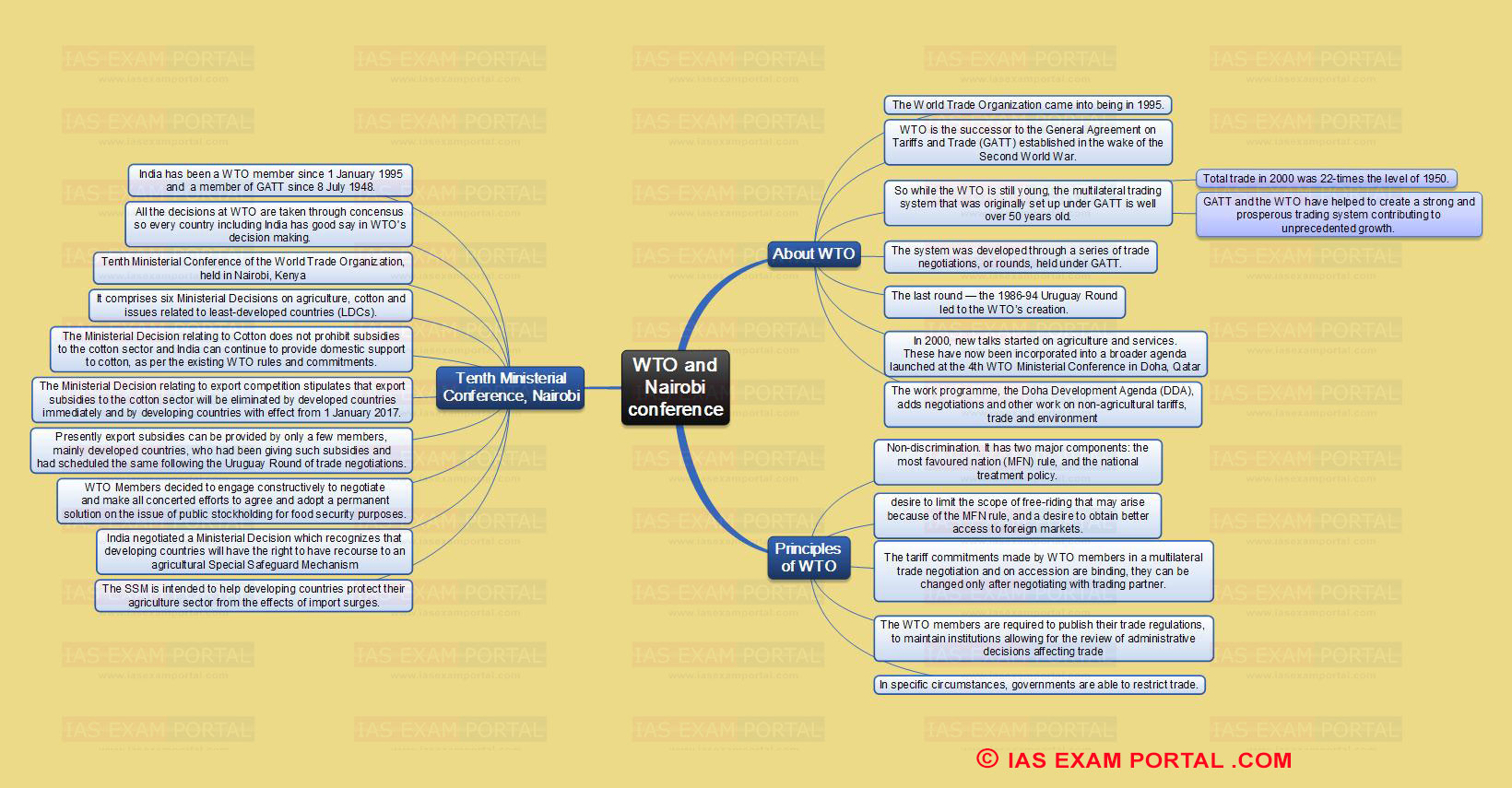NEW! The Gist (FREE) | E-BOOKS |
WTO and Nairobi Conference: Mind Map for UPSC Exam
WTO and Nairobi Conference: Mind Map for UPSC Exam
Click Here to Download Full MAP in PDF
Study Material for IAS Prelims: GS Paper -1 + CSAT Paper-2
Online Crash Course for UPSC PRE Exam
Mind Map Important Topics:
WTO and Nairobi conference
About WTO
- The World Trade Organization came into being in 1995.
- WTO is the successor to the General Agreement on Tariffs and Trade (GATT) established in the wake of the Second World War.
- So while the WTO is still young, the multilateral trading system that was originally set up under GATT is well over 50 years old.
- Total trade in 2000 was 22-times the level of 1950.
- GATT and the WTO have helped to create a strong and prosperous trading system contributing to unprecedented growth.
- The system was developed through a series of trade negotiations, or rounds, held under GATT.
- The last round — the 1986-94 Uruguay Round led to the WTO’s creation.
- In 2000, new talks started on agriculture and services. These have now been incorporated into a broader agenda launched at the 4th WTO Ministerial Conference in Doha, Qatar
- The work programme, the Doha Development Agenda (DDA), adds negotiations and other work on non-agricultural tariffs, trade and environment
Principles of WTO
- Non-discrimination. It has two major components: the most favoured nation (MFN) rule, and the national treatment policy.
- Desire to limit the scope of free-riding that may arise because of the MFN rule, and a desire to obtain better access to foreign markets.
- The tariff commitments made by WTO members in a multilateral trade negotiation and on accession are binding, they can be changed only after negotiating with trading partner.
- The WTO members are required to publish their trade regulations, to maintain institutions allowing for the review of administrative decisions affecting trade
- In specific circumstances, governments are able to restrict trade.
Tenth Ministerial Conference, Nairobi
- India has been a WTO member since 1 January 1995 and a member of GATT since 8 July 1948.
- All the decisions at WTO are taken through concensus so every country including India has good say in WTO's decision making.
- Tenth Ministerial Conference of the World Trade Organization, held in Nairobi, Kenya
- It comprises six Ministerial Decisions on agriculture, cotton and issues related to least-developed countries (LDCs).
- The Ministerial Decision relating to Cotton does not prohibit subsidies to the cotton sector and India can continue to provide domestic support to cotton, as per the existing WTO rules and commitments.
- The Ministerial Decision relating to export competition stipulates that export subsidies to the cotton sector will be eliminated by developed countries immediately and by developing countries with effect from 1 January 2017.
- Presently export subsidies can be provided by only a few members, mainly developed countries, who had been giving such subsidies and had scheduled the same following the Uruguay Round of trade negotiations.
- WTO Members decided to engage constructively to negotiate and make all concerted efforts to agree and adopt a permanent solution on the issue of public stockholding for food security purposes.
- India negotiated a Ministerial Decision which recognizes that developing countries will have the right to have recourse to an agricultural Special Safeguard Mechanism
- The SSM is intended to help developing countries protect their agriculture sector from the effects of import surges.

